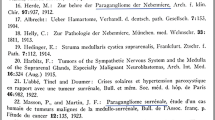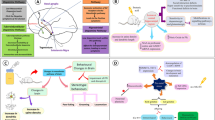Abstract
The effect of castration on the levels of brain monoamines and their metabolites has been investigated in rats which became or did not become muricidal following long-term isolation. Fourteen brain areas were explored: olfactory bulbs (OB), olfactory tubercles (OT), septum (Se), striatum (Sr), amygdala (A), thalamus (Th), hypothalamus (Hy), hippocampus (Hi), superior colliculus (SC), inferior colliculus (IC), raphe (Ra), pons-medulla (PM), frontal cortex (FC), temporal cortex (TC) and parietal cortex (PC). Except in the raphe of non muricidal rats and in the striatum of muricidal animals, all other areas examined demonstrate some changes of monoamines neurotransmitter or their metabolites after castration. The strongest changes, always increases, were found in the thalamus. In several brain areas, the changes occurring after castration, differ quantitatively and qualitatively in muricidal and non-muricidal rats.
Similar content being viewed by others
References
Brain, P. F. 1981. Hormones and aggression in infra-human vetebrates. Pages 181–213,in Brain, P. F., Benton, D. (eds.) The biology of aggression, The Netherlands: Sijthoff Et Noordhoff.
Brain, P. F., and Benton, D. 1981. The biology of aggression. Nato Advanced Study Institutes Series. The Netherlands: Sijthoff Et Noordhoff.
Gandelman, R. Androgen and fighting behavior. 1981. Pages 215–230,in Brain P. F., Benton, D. (eds.) The biology of aggression. The Netherlands: Sijthoff et Noordhoff.
Karli, P. 1958. Hormones stéroïdes et comportement d'agression interspécifique rat-souris. J. Physiol. Paris 50:346–347.
Ishikawa, K., Shibanok, S., Saito, S., and McGaugh, J. L. 1982. Effect of microwave irradiation on monoamine metabolism in dissected rat brain. Brain Res. 240:158–161.
Koenig, J. F. R., and Klippel, R. A. 1963. The rat brain: a stereotaxic atlas of the forebrain and lower parts of the brainstem. Baltimore: Williams and Wilkins.
Glowinski, J., and Iversen, L. L. 1966. Regional studies of catecholamines in the rat brain: the disposition of3H norepinephrine,3H dopamine and3H Dopa in various regions of the brain. J. Neurochem. 13:655–669.
Kempf, E., Fuhrmann, G., and Ebel, A. 1985. Genotypic variations in ethanol effect of striatal and hippocampal transmitter interactions. Alcohol 2:231–237.
Giacalone, E., Kostowski, W. 1969. Lesions of midbrain raphe in the rat: effect on levels of biogenic amines in forebrain and spinal cord. Pharmacol. Res. Comm. 1:84–88.
Karli, P., Vergnes, M., and Didiergeorges, F. 1969. Rat-mouse interspecific aggressive behaviour and its manipulation by brain ablation and by brain stimulation. Pages 47–55,in Garattini, S., Sigg, E. B. (eds.) Aggressive behaviour Amsterdam: Excerpta Medica Foundation.
Lorens, S. A., and Guldberg, H. C. 1974. Regional 5-hydroxytryptamine following selective midbrain raphe lesions in the rat. Brain Res. 78:45–56.
Molina, V., Ciesielski, L., Gobaille, S., and Isel, F. 1987. Inhibition of mouse killing behavior by serotonin-mimetic drugs: Effects of partial alterations of serotonin neurotransmission. Pharmacol. Biochem. & Behav. 27:123–131.
Vergnes, M., Mack, G., Kempf, E. 1973. Lesions due raphé et réaction d'agression interspécifique rat-souris. Effects comportementaux et biochimiques. Brain Res. 57:67–74.
Miczek, K. A., and Grossman, S. P. 1972. Effects of septal lesions on inter- and intraspecies aggression in rat. J. Comp. & Physiol. Psychol. 79:37–45.
File, S. E., James, T. A., and MacLead, N. K. 1981. Depletion in amygdaloid 5-hydroxy-tryptamine concentration and changes in social and aggressive behavior. Journal of Neural transmission 50:1–12.
Karli, P., Vergnes, M., Eclancher, F., Schmitt, P., and Chaurand, J. F. 1972. Role of the amygdala in the control of “mouse-killing” behaviour in the rat. Pages 553–580,in Eleftheriou, B. E., ed. The Neurobiology of the amygdala. New York: Plenum Press.
Wassman, M., and Flynn, J. P. 1962. Directed attack elicited from hypothalamus. Arch. Neurol. 6:220–227.
Aprison, M., and Hingtgen, J. 1972. Serotonin and behavior: a brief summary. Federation Proceedings 31:121–129.
Dichiara, G., Cauba, R., and Spano, P. F. 1971. Evidence for inhibition of brain serotonin on mouse-killing behavior in rats. Nature (London) 233:272–273.
Tagliamonte, A., Tagliamonte, P., Gessa, G. L., and Brodie, B. B. 1969. Compulsive sexual activity induced by p-chlorophenylalanine in normal and pinealtomized male rats. Sciences 166:1433–1435.
Mandel, P., Mack, G., Kempf, E., Ebel, A., and Simler, S. 1978. Molecular aspects of a model of aggressive behavior: Neurotransmitter interaction. Pages 285–303,in Garattini, S., Pujol, S. F., Samarin, R. (eds.) Interaction between putative neurotransmitters. New York: Raven Press.
Mandel, P., Mack, G., and Kempf, E. 1979. Molecular basis of some models of aggressive behaviour. Pages 95–110,in Sandler, M., (ed.) Psychopharmacology of Aggression. New York: Raven Press.
Mandel, P., Kempf, E., Mack, G., Haug, M., and Puglisi-Allegra, S. 1980. Neurochemistry of experimental aggression. Pages 61–71,in Valzelli, I., Morgese, I. (eds.) Aggression and Violence: a psychobiological and clinical approach. Milano: Edizioni St. Vincent.
Valzelli, L., and Garattini, S. 1972. Biochemical and behavioral changes induced by isolation in rats. Neuropharmacology 11:17–22.
Broderick, P. A., Barr, G. A., Sharpless, N. S., Bridger, W. H. 1985. Biogenic alterations in limbic brain regions of muricidal rats. Research Communications Chemistry Pathology Pharmacology 48:3–15.
Brain, P. F. 1979. Hormones drugs and aggression. Annual Research Reviews Vol. 3. Canada: Eden Press Inc.
Bernard, B. K., and Paolino, R. M. 1974. Time-dependent changes in brain biogenic amine dynamic following castration in male rats. J. Neurochem. 22:951–956.
Gessa, G. L., and Tagliamonte, A. 1974. Role of brain monoamines in male sexual behavior. Life Sciences 14:425–436.
Bell, R., Hepper, P. G. 1987. Catecholamines and aggression in animals. Behav. Brain Res. 23:1–21.
Anden, N. E., Butcher, S. G., Corrodi, H., Fux, K., and Ungersted, U. 1970. Receptor activity and turnover of dopamine and noradrenaline after neuroleptics. Eur. J. Pharmacol. 11:303–309.
Kebabian, J. W., and Calne, D. B. 1979. Multiple receptors for dopamine. Nature (London) 277:93–96.
McKenzie, G. M. 1971. Apomorphine-induced aggression in the rat. Brain Res. 34:323–330.
Miller, R. J., Kelly, P. H., and Neumeyer, J. L. 1976. Actions of apomorphine alkaloids on dopaminergic mechanisms in rat brain. Eur. J. Pharmacol. 35:77–83.
Schneider, C. 1968. Behavioural effects of some morphine antagonists and hallucinogens in the rat. Nature (London) 220:586–587.
Scott, J. P. 1958. Aggression. Chicago: University Chicago Press.
Gessa, G. L., Tagliamonte, A. 1975. Role of brain serotonin and dopamine in male sexual behavior,in Sandler, M., Gessa, G. L. (eds.) Sexual behavior: pharmacology and biochemistry. New York: Raven Press.
Iwasaki, K., Fujiwara, H., Shibata, S., and Ueki, S. 1986. Changes in brain catecholamine levels following olfactory bulbectomy and the effect of acute and chronic administration of desimipramine in rats. Pharmacol. Biochem. Behav. 24:1715–1719.
Barr, G. A., Sharpless, N. S., and Gibbons, J. L. 1979. Differences in the level of dopamine in the hypothalamus of aggressive and non-aggressive rats. Brain Res. 166:211–216.
Rastegar, A., Simler, S., Ciesielski, L., and Mandel, P. 1992. Regional studies of brain biogenic amines in castrated muricidal and on muricidal Wistar rats. Aggr. Behav. 18:289–299.
Author information
Authors and Affiliations
Additional information
Special issue dedicated to Dr. Claude Baxter.
Prof. P. Mandel passed away on October 6th, 1992.
Rights and permissions
About this article
Cite this article
Rastegar, A., Ciesielski, L., Simler, S. et al. Brain monoamines following castration of aggressive muricidal rats. Neurochem Res 18, 471–477 (1993). https://doi.org/10.1007/BF00967251
Accepted:
Issue Date:
DOI: https://doi.org/10.1007/BF00967251




